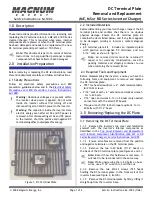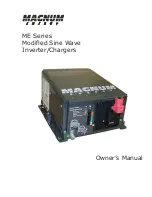
Page 54 Non-Sound Decoder MX618 - MX638 and Sound Decoder MX640 - MX659
Note: many locomotive manufacturers supply field magnets that can be used in place of the motor’s
field coil. Using a field magnet turns an AC motor into a DC motor, which is connected as such (see
above) and can also utilize the decoders BEMF feature (BEMF does not work with AC motors).
Additional hook-up for cab lighting controlled with F0 key:
This is no longer of much use today; it is a remainder from a time when decoders only had two func-
tion outputs, which were used for the headlights and the cab light. Cab lights connected this way can
be switched with the F0 key but in contrast to the headlights were non-directional.
This is however a general schematic that can be used in cases where something is to be operated by
several different function outputs, but the same outputs used independent of each other. There are 2
diodes required (type 1N4007 or equivalent) available from ZIMO or any electronic parts supply store.
Blue
Yellow
White
Headlights
Rear Front
2 Diodes
1N4007
Cab light bulb
Connecting function outputs FO1, FO2, FO3, FO4…:
Depending on decoder type, function outputs FO1 and higher are available on wires, solder pads or
part of a connector (i.e. the MX620 offers FO1 and FO2 on solder pads, the MX630 and MX632 on
wires and further outputs on solder pads) and can be connected in the same fashion as headlights.
For mapping the outputs to function keys, see chapter 5; the function outputs FO1 and FO2 are
mapped by default with function keys F1 and F2.
Also see note on MX632 below!
Red
Black
blue
Yellow
White
Solder pad FO1
Right rail
Left rail
Headlights
Rear Front
E
.g
.
C
a
b
l
ig
h
t
Using logic level outputs:
ZIMO decoders also have so called logic level outputs in addition to the normal function outputs, to
which current consuming devices may not be connected directly. Use a ZIMO M4000A amplifier or
similar transistor switching device, when connecting logic level outputs with a load.
Some logic level outputs are used alternatively for the “SUSI-CLOCK” and SUSI-DATA” connections
and can be switched to logic level outputs when setting CV #124 Bit 7 = 1 (if SUSI is not required).
Furthermore, the same pins can be used for servo control (activated with CV’s #181 & 182).
NOTE on MX632:
The logic level outputs FO5 and FO6 of the MX632 are identical in their function as
the amplified outputs FO5 and FO6 (not FO7 and FO8 as was first announced erroneously); however,
if
“SUSI” (CV #124, Bit 7) or servo control (CV’s #181, 182) is active, neither the amplified out-
puts FO5/FO6 nor the logic level outputs FO5/FO6 will be functional!!
The brown lead of an
amplifier module M4000Z
is connected with the relevant logic level output sol-
der pad of the decoder.
To tra c k
B row n
2 x bla c k
B lue (+ )
G re e n (-)
e.g.
Sm oke generator,
uncoupler etc.
M 4 0 0 0 Z
C o n n e ct to S U S I-C L OC K o r S U S I-D ATA so ld e r
p a d s o f th e M X 6 2 0 , co n ve rt th e o u tp u ts to fu n ctio n
o u tp u ts w ith C V # 1 2 4 , B it 7 .
Connecting DIETZ sound modules
without “SUSI” / “virtual cam sensor”
Consult the Dietz instruction manual regarding the installation and connection of their sound modules
to a ZIMO decoder.
For a good acoustic impression of steam engines, it is important that the chuffs are synchronized to
wheel revolutions. Therefore a cam sensor should be installed and connected to the sound module
(reed switch, optical or hall-effect sensor), which sends exactly 2 or 4 pulses to the module (depend-
ing on loco type).
If no cam sensor can be installed or an installation proves too difficult, many sound modules can also
generate their own chuff rate based on speed information (e.g. coming through the SUSI interface
from the decoder). The result is often poor with a chuff rate that is too fast at low speeds (the SUSI
protocol is not precise enough in that respect).
To improve this situation, ZIMO decoders come with a built-in
“virtual cam sensor”.
The function
output FO4 is used for this purpose,
converted to a “virtual cam sensor” function with the help of CV
#133 and connected with the cam sensor input of the sound module (e.g. Dietz, reed switch input);
this in addition to SUSI or other connections.
The virtual cam sensor is of course not capable of synchronizing chuff rates to wheel positions but ra-
ther to wheel speed, which is of little difference to the viewer.
The chuff rate of the “virtual cam sensor” can be adjusted to wheel revolutions with CV #267 and CV
#354; consult the CV table in ZIMO sound chapter.
Connecting of DIETZ or other sound modules with “SUSI”:
The SUSI interface developed by Dietz is an NMRA standard and defines the connection between
sound modules and loco decoders, provided the sound module is also equipped with such an inter-
face.
Due to space restrictions on small decoders, the SUSI interface composed of 4 conductors (2 data,
ground and power) is not built as a plug-in connector but instead uses
4 solder pads
(see decoder
drawings in the chapter “Technical specifications” in this manual).
Speed and load information (uphill, downhill, startup etc.), as well as programming values for the
sound module CV’s (#890…) are sent via the SUSI data lines (CLOCK and DATA) from the decoder
to the sound module.
Accessing SUSI CV’s in the SUSI module:
These CV’s are in the 890 range, according to the
standard (NMRA DCC Draft RP), which is not accessible with many DCC systems (ZIMO cabs MX2
and MX21 were also limited to 255 - until mid-2004). For this reason, ZIMO decoders allow access to
these CV’s with numbers in the 190’s!
















































